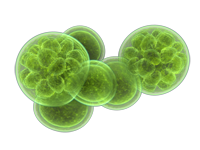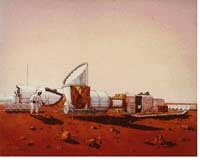NASA
From 2011.igem.org
Space Synthetic Biology – a Tool for Space Science and Exploration
NASA's mission is broadly defined: "to pioneer the future in space exploration, scientific discovery and aeronautics research". Synthetic Biology will one day provide more efficient, lower cost, practical approaches to specific challenges in space. NASA programs can derive significant benefits by utilizing this emerging field to create advances for biological life support and in situ resource utilization, for advanced sensing, advanced materials, and for research in the origins and evolution of life.
The NASA Space Synthetic Biology Project is designed to harness biology in reliable, robust, engineered systems to support NASA’s exploration and science missions, to improve life on Earth, and to help shape NASA’s future. The project is also intended to contribute foundational tools to the synthetic biology community. It is led by the NASA Ames Research Center. See our website at http://syntheticbiology.arc.nasa.gov/.
While advances in biosciences and biotechnology will no doubt transform the world in this “century of biology,” Synthetic Biology in particular holds the potential for rapid, game-changing advances, since it allows the acquisition of novel functions, and at speeds, unknown by evolution up to this time. This is particularly relevant to NASA’s long-term exploration missions, which will require biological systems and ecosystems to be sustained in extraterrestrial environments. Biological systems that have evolved in terrestrial environments generally are not well suited for the extraterrestrial environments characteristic of NASA’s anticipated missions. Until now, NASA’s typical solution has been to sustain life in space by engineering suitable environments. Advances in Synthetic Biology will provide complementary capability to engineer biological systems better suited to extraterrestrial environments.
As a participant in iGEM, we hope you will consider exploring projects related to space technology needs, including:
- Closed-loop Life Support Systems - Conversion of carbon dioxide to oxygen, advanced wastewater treatment, conversion of solid waste to useful products (fuels, food, plastic), enhanced food production
- In Situ Resource Utilization (ISRU) –Systems for resource extraction and utilization from in situ sources as well as recycled spacecraft materials, and materials acquired in transit. What could be produced from the materials available on asteroids, Mars or the moon, or the International Space Station? How can Synthetic Biology help optimize these systems?
- Advanced Sensors – Biologically-mediated and regenerable sensors for highly selective/sensitive detection of organic and inorganic materials
- Advanced Materials – Terrestrial and in situ production of biological and bio-inspired micro/macro materials
- Establishment of Life in Extraterrestrial Environments – Engineer organisms with increased tolerance to radiation, temperature and toxins and the potential to use alternative metabolic energy sources (e.g., radiation instead of photons/chemical energy)
Links to past iGEM projects specifically related to space applications:
- Team Valencia: Mad yeast on Mars, iGEM 2010
- Team Tokyo_Tech: 2009 Space Odyssey: Terraforming of Mars with genetically engineered bacteria, iGEM 2009
Links to past iGEM projects with relevance to space applications:
- Team Newcastle: BacillaFilla: Filling Microcracks in Concrete, iGEM 2010 (space application: Advanced Materials)
- Team ULB-Brussels: Hydrocoli : How to make wastewater our new green energy source, iGEM 2010 (space application: Closed-loop Life Support Systems)
- Team Imperial_College_London: Parasight – Parasite detection with a rapid response, iGEM 2010 (space application: Advanced Sensors)
- Team MIT: Programmable, Self-Constructing Biomaterials, iGEM 2010 (space application: Advanced Materials)
- Team Peking: Heavy Metal Decontamination Kit, iGEM 2010 (space application: Advanced Sensors)
We identified these prior iGEM projects as representative examples, but certainly they are not the only ones relevant to space science and exploration – We hope you will identify new innovative concepts and continue to build on the iGEM legacy to support Space Synthetic Biology.
Selected publications and reviews:
- Cumbers J, Rothschild, L.J. 2010. BISRU: Biological In Situ Resource Utilization. Astrobiology Science Conference 2010: Evolution and Life: Surviving Catastrophes and Extremes on Earth and Beyond, held April 26-20, 2010 in League City, Texas. LPI Contribution No. 5672.
- Kelly JR, Rubin AJ, Davis JH, Ajo-Franklin CM, Cumbers J, Czar MJ, de Mora K, Glieberman AL, Monie DD, Endy D. 2009. Measuring the Activity of BioBrick Promoters Using an In Vivo Reference Standard. J Biol Eng. Mar 20;3(1):4.
- Mitsuzawa S, Kagawa H, Li Y, Chan SL, Paavola CD, Trent JD. 2009. The rosettazyme: a synthetic cellulosome. J Biotechnol. 20;143(2):139-44.
- Rothschild, L.J. 2010. A powerful toolkit for synthetic biology: over 3.8 billion years of evolution. BioEssays 32:304–313.
- Rothschild, L.J. 2010. Evolution, Synthetic Life, and The Tin Woodman Dilemma J. Cosmology 8.
- Rothschild, L.J. 2010. What Synthetic Biology Can Do For Astrobiology. Astrobiology Science Conference 2010: Evolution and Life: Surviving Catastrophes and Extremes on Earth and Beyond, held April 26-20, 2010 in League City, Texas. LPI Contribution No. 5565.
- Gerda Horneck, David M. Klaus and Rocco L. Mancinelli. 2010. Space Microbiology. MICROBIOLOGY AND MOLECULAR BIOLOGY REVIEWS, Mar. 2010, p. 121–156.
 "
"



